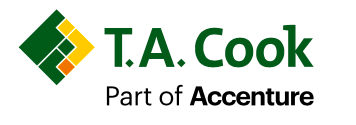From Colemann O’Malley, Manager
T.A. Cook
Part of Accenture
(tacook.com)
It’s often said that “reliability happens in the field.” Given the global pandemic, however, engineers may not have spent as much time at the plant and in units as they once did. So, how can reliability, asset, and maintenance engineers positively impact equipment performance when they are unable to be physically near the equipment they service?
According to the following article by T.A. Cook’s Colemann O’Malley, the answer lies in the use of simple tools to implement some advanced practices in reliability modeling.
Most organizations struggle to advance their asset management approach under the best conditions. So how can a forced remote work situation present itself as an opportunity rather than a setback? How can we use existing, simple, and common data to maximize this opportunity?
In terms of reliability maturity, the modeling of failure modes and effects is most often considered an advanced element of asset management. These types of models frequently include Weibull analysis, risk assessment and mitigation, and PM task identification or optimization. They also typically require a more intensive level of data than is readily available to engineers. During this period of remote support, however, engineers have the unique opportunity to focus on these advanced elements of asset management.
These models do not require advanced datasets and analytics to provide value, however. An engineer can usually get a lot out of these models by using the data at hand.
For example, building a life cycle cost model around a specific piece of equipment is a relatively straightforward task. This involves determining the install date, acquisition cost, and realized actual cost of maintenance activities completed on the asset – which can be extracted from many computerized maintenance management systems (IW39 t-code in most SAP instances) – or even interpolated from budget execution data. An example of such a model, as applied to a cooling tower, is shown in Fig. 1.
 Fig. 1. Actual life-cycle cost to date.
Fig. 1. Actual life-cycle cost to date.
Here, the cumulative cost of owning and maintaining the asset has increased since the installation in 2010. For many sites, pulling and plotting this data is already a new tool for asset management. The real learning from this exercise, however, comes from utilizing a simple Excel analysis approach to understand the drivers behind this life-cycle cost plot.
This can be accomplished through a dominant failure mode analysis. If a robust criticality exists, it can serve as an excellent starting point for this approach. For example, a cooling tower asset criticality may look like the assessment shown in Fig. 2, where the worst credible failure mode that was assessed was a cell structural failure. While this may result in a cell collapse, it is most often identified as sagging water decks, fan vibration, or a partial failure.
 Fig. 2. Cooling tower criticality.
Fig. 2. Cooling tower criticality.
Here, we have an assessed economic loss of >$500,000 per event with a likelihood of 1-10%, or an expected life between 10-100 years. How can we apply this analysis to the life cycle cost model above?
Despite the apparent disconnect, these two analyses should be strongly correlated. This is evident with a Weibull analysis of the same dominant failure mode analyzed in the criticality analysis. By applying and refining that same assessment, an unmitigated life-cycle cost model can be built around the asset. This model will show the worst-case potential of the life cycle cost, based on a lack of any proactive tasks.
 Fig. 3. Unmitigated life-cycle costs.
Fig. 3. Unmitigated life-cycle costs.
Here, the modeled unmitigated costs closely match the actual costs on the asset. In fact, a simple correlation analysis in Excel can show that this model has an R2 coefficient greater than 0.9. From this two-step model, a discerning engineer can begin to build the business case for intervention in this asset’s life cycle approach. It clearly shows how, if left unmitigated, the cost of ownership of this equipment will continue to grow unchecked.
Now that the unmitigated model is complete, it is relatively easy to model the risk after a mitigating action is implemented. This model can be used to further enhance the business case for developing or revisiting an equipment strategy.
By modeling the risk after implementing an effective mitigating action, the business can easily see the benefit of taking a new reliability strategy.
 Fig. 4. Mitigated life-cycle costs.
Fig. 4. Mitigated life-cycle costs.
In the example of this cooling tower, the benefit of a new strategy is abundantly clear. In fact, the projected one=year benefit is estimated at $250k. Although reliability may happen in the field, there will be no support for new efforts in the field if a compelling business justification is not made to management. This simple, Excel-based analysis can be used as the driver for re-evaluating this cooling tower’s strategy.
This analysis, depicting a three-year benefit that exceeds $4M, was built using two simple and common sets of data: CMMS work order export and criticality ranking. This approach, and others like it, can be accomplished entirely remotely using minimal data. However, the ease of this approach does not detract from its effectiveness – in fact it only adds to it. Years of asset strategy development can be accomplished effectively and efficiently in a remote setting, which is free from the daily interruptions and reprioritization associated with work onsite.
The global pandemic has had profound impacts on the process industries, including engineers’ ability to practice field-based reliability. However, by using basic data and simple digital tools, a reliability engineer can effectively enhance a site’s asset -management approach from a home office.
These approaches don’t need an extensive digitalization effort, online monitoring, or advanced tools. In many regards, the remote work situation is better suited for this advanced reliability work than a site-based approach, where day-to-day interruptions prevent progress in developing these strategies. The value in such approaches is clear, with the ability to drastically improve a site’s approach to asset management and deliver results even with limited working capability.♦ ♦ ♦
CLICK HERE FOR MORE INFORMATION




